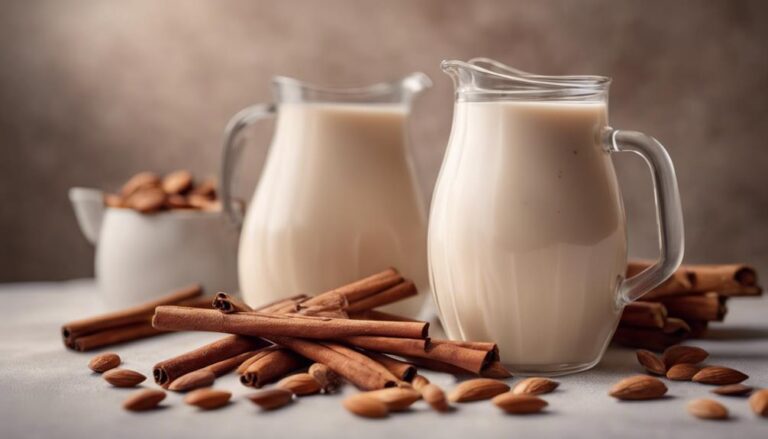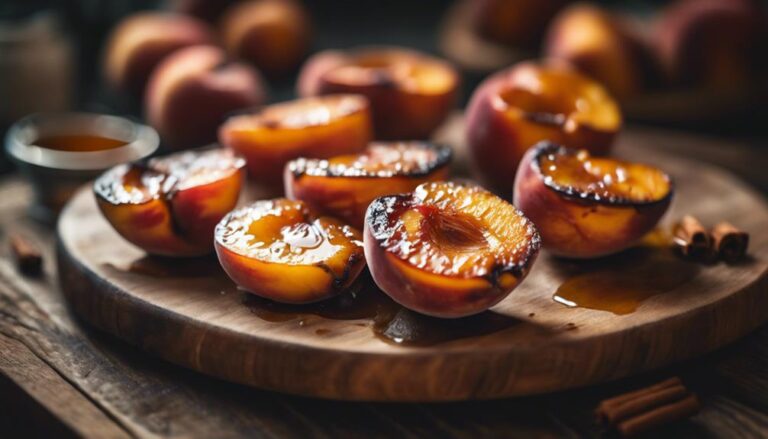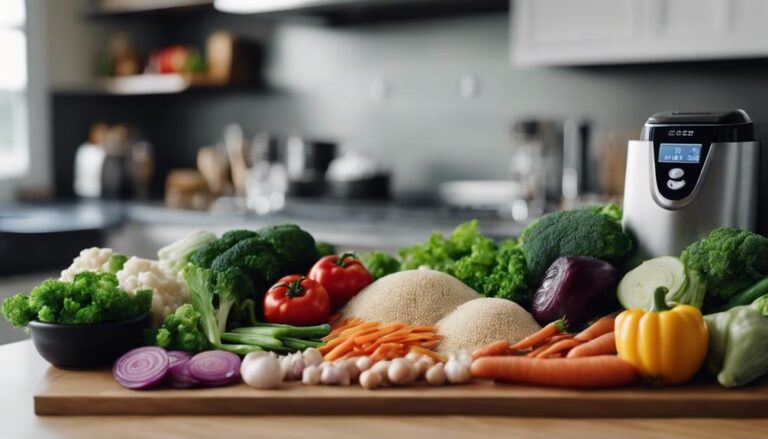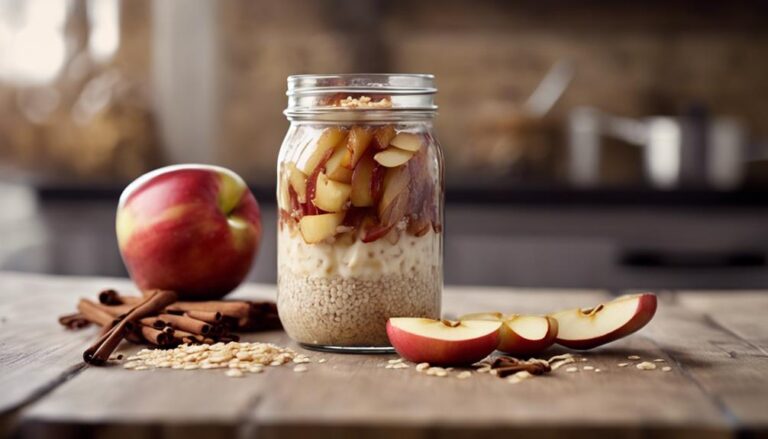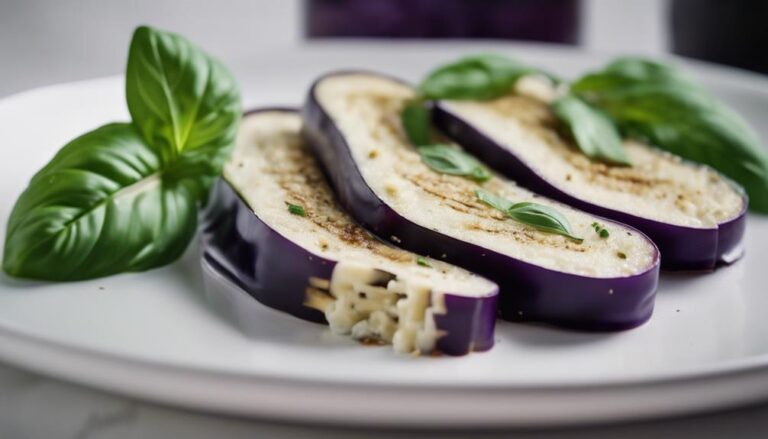Sous Vide Green Tea With Mint
Experience a superior blend by infusing mint with green tea using the sous vide technique. The method's precision guarantees a consistent and full-bodied flavor profile. The mint's freshness perfectly complements the earthy notes of green tea, offering a revitalizing brew. Elevate your tea-making routine with this innovative approach.
What You Will Learn Here
- Sous vide method ensures precise temperature control for perfect green tea infusion.
- Fresh mint enhances the green tea flavor with a refreshing twist.
- Consistent results with sous vide create a well-rounded and balanced tea experience.
- Mint complements the grassy notes of green tea, creating a harmonious blend.
- Elevate your tea-making routine by using sous vide for a unique and flavorful green tea with mint.
Tea's Origins in Asia
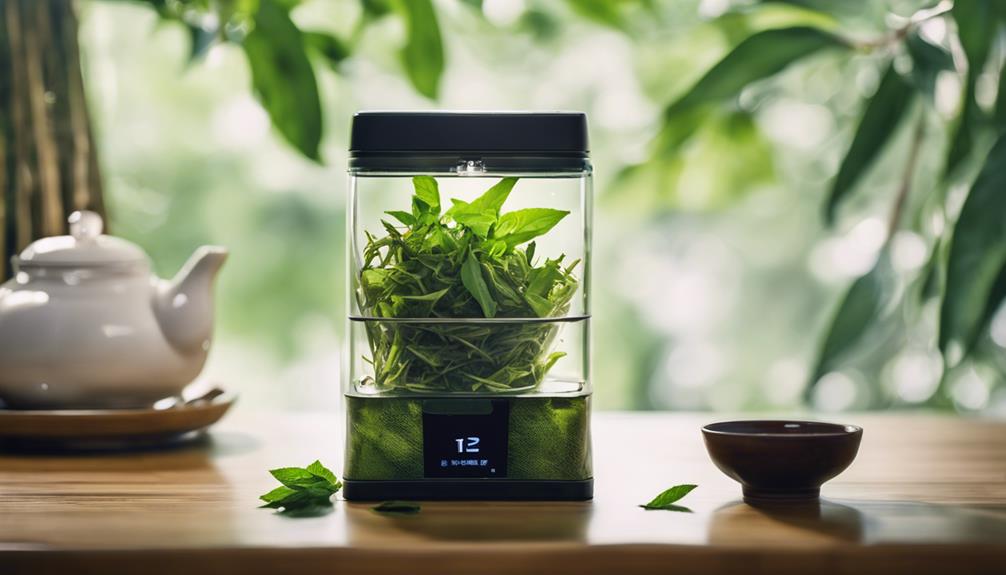
Asian tea history dates back thousands of years, with China often credited as the birthplace of tea cultivation practices.
Tea plays a significant role in various Asian cultures, leading to the development of elaborate traditional tea ceremonies that emphasize mindfulness and respect for the beverage.
Understanding the origins of tea in Asia provides valuable insight into the deep-rooted cultural significance and diverse practices surrounding this beloved beverage.
Asian Tea History
The origins of tea in Asia date back thousands of years, with its rich history intertwined with cultural traditions and medicinal practices. Chinese influence played a significant role in the early cultivation and consumption of tea, leading to its spread to neighboring regions. Japanese tradition, on the other hand, refined the art of tea ceremonies, elevating tea drinking to a spiritual and aesthetic experience. Below is a table summarizing key points in Asian tea history:
| Time Period | Key Developments | Significance |
|---|---|---|
| Ancient China | Discovery of tea's medicinal properties | Initiated tea's consumption for health benefits |
| Tang Dynasty | Tea became a popular social drink | Tea culture began to flourish in China |
| Japanese Tea Ceremony | Formalized tea rituals | Influence of Zen Buddhism on tea culture |
Tea Cultivation Practices
Tea cultivation practices in ancient Asia evolved in response to a deep understanding of the plant's growth requirements and the desire to cultivate the highest quality leaves for consumption. Essential farming methods were pivotal in ensuring the longevity of tea plantations.
Organic practices, such as avoiding synthetic pesticides and fertilizers, were employed to maintain soil health and protect the environment. Farmers would often intercrop tea with other plants to enhance biodiversity and promote natural pest control.
Additionally, traditional irrigation systems were designed to efficiently water the tea plants while conserving water resources. These meticulous cultivation practices not only yielded exceptional tea leaves but also reflected a profound respect for the land and a commitment to sustainable agriculture in ancient Asia.
Traditional Tea Ceremonies
Indulging in ceremonial practices rooted in ancient traditions, one immerses oneself in the intricate world of tea rituals that have shaped cultures across the globe.
Japanese tea ceremonies, known as 'chanoyu' or 'sado,' emphasize harmony, respect, purity, and tranquility. These ceremonies, deeply influenced by Zen Buddhism, involve precise movements, etiquette, and the serving of matcha green tea.
Chinese tea culture, on the other hand, boasts a rich history dating back thousands of years. The Chinese tea ceremony focuses on the preparation and presentation of tea, highlighting the appreciation of tea leaves' aroma, taste, and appearance.
Both the Japanese and Chinese tea ceremonies showcase the profound connections between tea, spirituality, and social interactions. Embracing these traditions allows one to honor the origins of tea while experiencing a moment of serenity and mindfulness.
Tea Varieties for Infusion
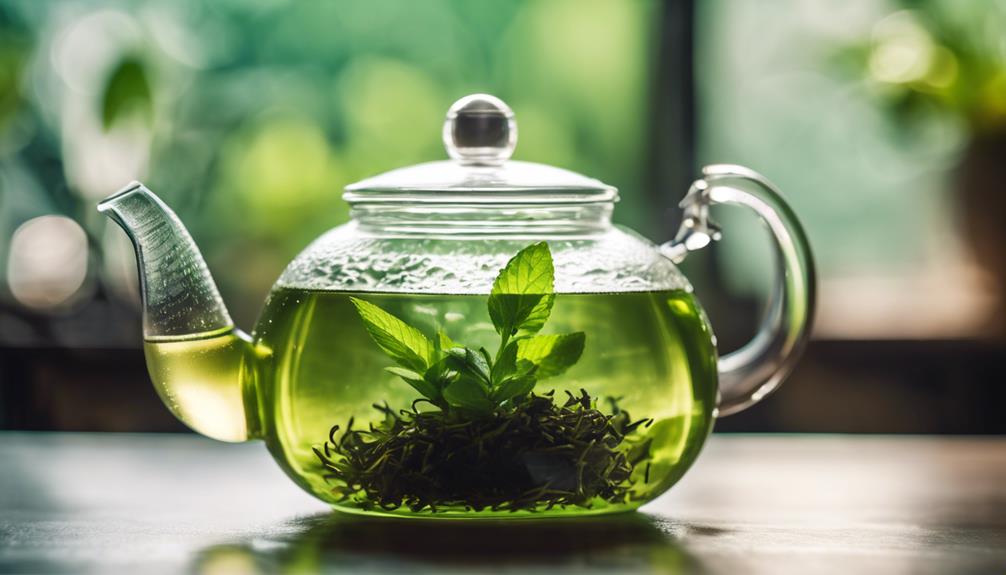
When selecting varieties for infusion, consider the flavor profiles and caffeine levels of different teas to enhance the overall taste experience. Here is a comparison of popular tea varieties for infusion along with their health benefits:
- Green Tea: Known for its fresh, grassy flavor and medium caffeine content, green tea is rich in antioxidants that promote overall well-being.
- Black Tea: With a robust flavor and higher caffeine levels, black tea is linked to improved heart health and digestion.
- White Tea: Delicate and subtly sweet, white tea has the least caffeine and is praised for its skin-boosting antioxidants.
- Herbal Tea: Herbal blends like chamomile or peppermint offer caffeine-free options with various health benefits such as relaxation and digestion aid.
Matcha Infused Delights
Explore the delightful world of matcha-infused treats with our selection of green tea delights. Craft a velvety Green Tea Latte that balances the earthy notes of matcha with creamy milk for a comforting sip.
For a burst of invigorating flavor, try our recipe for a Minty Green Tea that revitalizes your taste buds with every cooling sip.
Indulge your sweet tooth with a scoop of homemade Green Tea Ice Cream, a luscious treat that combines the richness of cream with the subtle bitterness of matcha for a harmonious dessert.
Green Tea Latte Recipe
To craft a delightful Green Tea Latte, start by whisking matcha powder with a small amount of hot water until smooth and frothy. This vibrant and invigorating drink combines the earthy flavors of matcha with the creaminess of milk, resulting in a satisfying beverage perfect for any time of day.
Here are four essential steps to create a perfect Matcha Latte:
- Choose the right matcha: Opt for high-quality ceremonial grade matcha for the best flavor.
- Heat the milk: Heat your milk of choice until steaming but not boiling.
- Mix well: Make sure the matcha is fully dissolved in the water before adding the milk.
- Sweeten to taste: Add a touch of sweetener like honey or sugar if desired.
Enjoy your homemade Matcha Latte with a hint of mint infusion for an extra invigorating twist!
Refreshing Mint Green Tea
For a rejuvenating twist on traditional green tea, infuse your matcha with the invigorating essence of mint to create a delightful and revitalizing beverage. Here's why you should try this invigorating Mint Green Tea:
- Herbal infusion: Mint is a natural herb known for its calming and soothing properties, making it an excellent addition to your tea for a relaxing experience.
- Minty refreshment: The minty flavor combined with the earthy notes of matcha creates an invigorating and energizing drink that will awaken your senses.
- Antioxidant boost: Matcha is rich in antioxidants, while mint is known for its potential health benefits, making this tea a powerhouse of goodness.
- Balanced flavors: The combination of mint and matcha offers a perfect balance of flavors, creating a harmonious taste profile that's both satisfying and enjoyable.
Green Tea Ice Cream
Indulge in the creamy decadence of Green Tea Ice Cream, infused with the rich flavors of matcha for a delightful frozen treat.
Discover the Magic of Green Tea Ice Cream:
- Tea Inspired Desserts: Explore the world of tea-inspired desserts with this unique twist on traditional ice cream.
- Innovative Flavors: Experience the innovative flavors that come to life when matcha meets creamy ice cream.
- Unique Tea Pairings: Delight in the harmonious pairing of matcha and dairy, creating a flavor profile like no other.
- Flavor Combinations: Savor the perfect balance of earthy matcha and sweet cream in every scoop.
Experience the blissful combination of green tea and dessert in a delectable form that will leave your taste buds craving more.
Brewing Green Tea Perfectly
To brew green tea perfectly, consider the importance of water temperature, as it can greatly impact the taste and aroma.
Experiment with steeping time variations to find the ideal balance between flavor extraction and bitterness.
Explore different brewing vessel options such as teapots, gaiwans, or even simple mugs to enhance your tea experience.
Water Temperature Importance
Understanding the ideal water temperature is essential for brewing green tea perfectly. Temperature control plays a critical role in flavor extraction when making green tea. Water that's too hot can scald the delicate tea leaves and result in a bitter taste, while water that's too cold may not extract enough flavor.
For green tea, the recommended water temperature is typically around 175°F to 185°F (79°C to 85°C). At this temperature range, the tea leaves can release their flavors smoothly, resulting in a well-balanced brew. Maintaining the correct water temperature throughout the brewing process is key to achieving a delicious cup of green tea that's both flavorful and invigorating.
Steeping Time Variations
For ideal flavor extraction in your green tea, the steeping time variations play a crucial role in achieving the perfect brew. Different steeping techniques can bring out various flavor profiles in green tea. Shorter steeping times generally result in a lighter, more delicate taste, while longer steeping times can intensify the flavor, sometimes leading to bitterness.
Infusion experimentation is key to finding the best steeping time that suits your preferences. It's worth noting that green tea not only offers a wide range of flavors but also numerous health benefits. Adjusting steeping times allows you to control the strength of these benefits.
Brewing Vessel Options
Consider selecting a brewing vessel that complements the nuanced flavors of green tea to guarantee a perfect brew. When choosing the ideal vessel, keep in mind factors like temperature control and infusion techniques to enhance the taste and aroma of your green tea. Here is a comparison table to help you make an informed decision:
| Brewing Vessel | Temperature Control | Infusion Techniques |
|---|---|---|
| Glass Teapot | Good | Best for loose leaf |
| Ceramic Mug | Moderate | Suitable for bags |
| Cast Iron Teapot | Excellent | Retains heat well |
| Stainless Steel Pot | Limited | Durable and easy to clean |
| Porcelain Cup | Limited | Delicate flavor preservation |
Final Thoughts
In conclusion, the overall infusion of green tea with mint using the sous vide method yields a harmonious blend of flavors that are subtly enhanced and delicately balanced. Reflections on the process reveal the advantages of sous vide for tea-making, providing a more controlled and precise environment for extracting flavors while preserving the delicate nuances of both green tea and mint leaves. The impact of this method is notable in the resulting taste profile, where the mint's freshness complements the grassy notes of the green tea without overpowering them.
The experience of preparing green tea with mint using sous vide isn't only convenient but also rewarding, allowing for a hands-off approach that guarantees consistent results. The gentle infusion process ensures a smooth and well-rounded flavor that's free from bitterness or astringency. Overall, incorporating sous vide into your tea-making routine can elevate your brewing experience, offering a new level of precision and quality to your daily cup of tea.
Frequently Asked Questions
Can I Reuse the Sous Vide Green Tea Leaves for Another Infusion?
When reusing tea leaves, consider the flavor profiles and steeping techniques. Reused leaves may provide a milder taste but still hold some essence.
However, multiple infusions can affect the overall quality of the tea. To maximize flavor, try slightly adjusting the steeping time or temperature for subsequent brews.
Experiment with different methods to maintain the tea's quality and enjoy multiple cups from the same leaves.
How Does Sous Vide Green Tea Compare to Traditionally Brewed Tea?
When comparing sous vide green tea to traditionally brewed tea, you'll notice differences in flavor profiles and brewing methods. Sous vide can extract flavors more gently and evenly, resulting in a smoother taste.
However, traditional brewing methods may offer a more robust and complex flavor due to varying water temperatures and steeping times.
Caffeine content and antioxidant levels can vary depending on the brewing method used, impacting the overall health benefits of the tea.
Are There Any Health Benefits Specific to Sous Vide Green Tea?
When it comes to the health benefits of sous vide green tea, the sous vide method can enhance the extraction of antioxidants and nutrients from green tea leaves.
This gentle, controlled cooking process helps retain more of the tea's beneficial compounds compared to traditional brewing methods.
Can I Add Sweeteners or Flavorings to My Sous Vide Green Tea?
When preparing sous vide green tea, you have various sweetener options and flavoring possibilities to enhance the taste. Sweeteners like honey, sugar, or stevia can be added to customize the sweetness level to your liking.
Flavorings such as mint, lemon, or ginger can impart unique and invigorating flavors to your tea. Experiment with different combinations to find the perfect balance that suits your preferences.
Is It Possible to Adjust the Strength of the Tea by Changing Cooking Times?
To adjust the strength of your tea, consider experimenting with steeping variations. By altering the cooking times during the infusion process, you can customize the flavor to your liking.
Varying the duration of the sous vide method can lead to different tea strengths, allowing you to tailor the taste to suit your preferences.
Have fun exploring different infusion times to find the perfect balance for your ideal cup of tea.
Conclusion
To sum up, sous vide green tea with mint offers a unique and flavorful experience that combines the delicate taste of green tea with the invigorating aroma of mint.
By infusing tea in a controlled temperature environment, you can extract maximum flavor and nutrients, creating a perfectly brewed cup every time.
This method allows for a consistent and enjoyable tea experience that's sure to impress even the most discerning tea enthusiasts.







